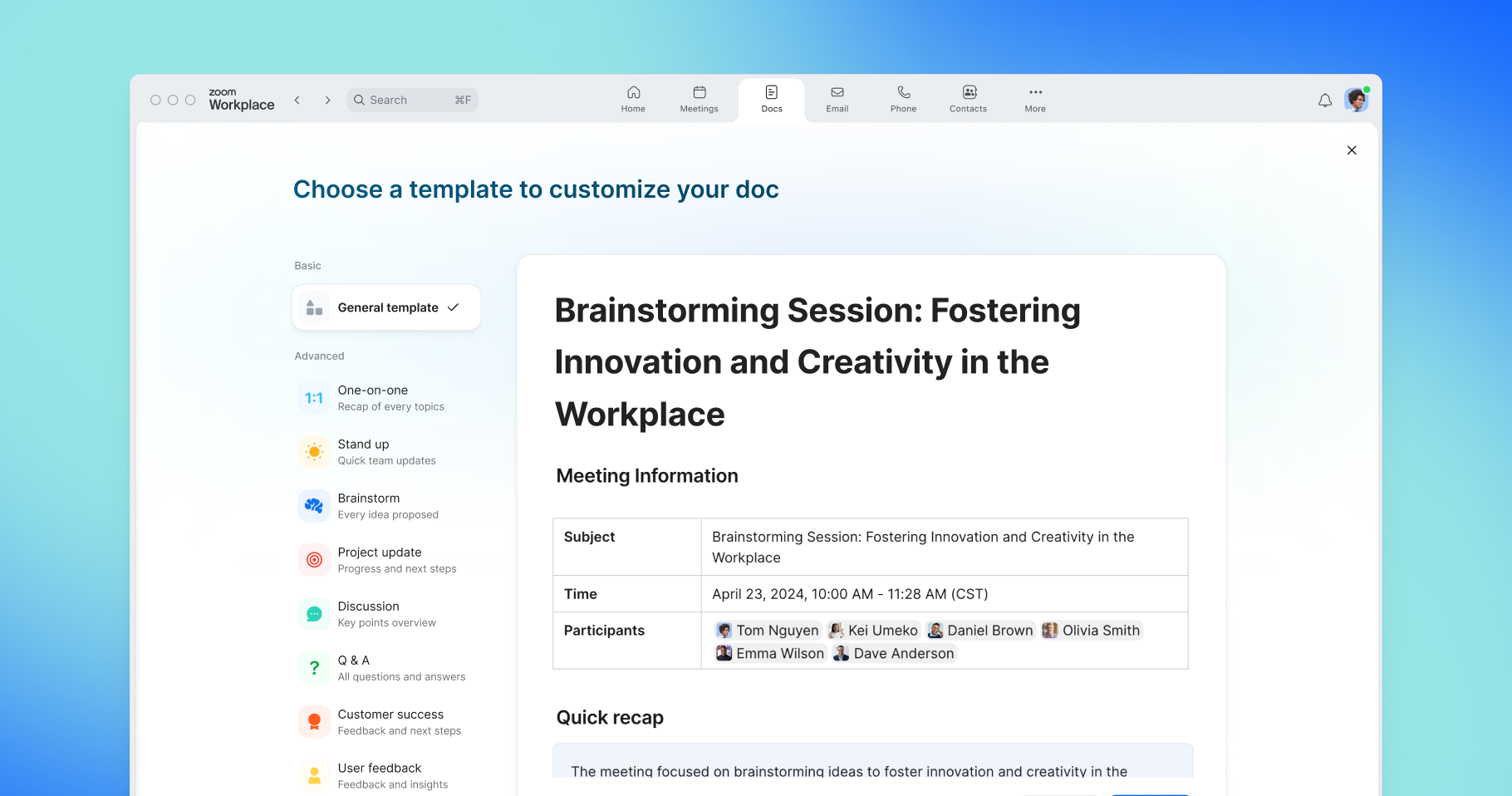
Your guide to getting started with Zoom Docs [2025]
Get to know Zoom Docs with AI Companion — follow our tips for creating collaborative docs using meeting summaries and transcripts, templates, and more.
Updated on September 29, 2022
Published on January 20, 2022


Whether you’re working from home or in an office, communication is critical to the success of your organization and its employees. Effective communication plays a key role in building strong, productive teams that work collaboratively toward a common goal.
On the other hand, ineffective communication can lead to a breakdown in productivity and company culture, sow mistrust and uncertainty, or cause confusion and frustration among employees. This can have serious repercussions for your organization, so if your team is struggling with miscommunication, read on for some common causes and tips for improving how you communicate at work.
Technology has made us more connected to one another than ever, even as we’ve grown increasingly more mobile. Thanks to smartphones, laptops, tablets, and other devices, we can connect with colleagues and clients at a moment’s notice, even when we’re not at a physical office location.
This “era of flexibility” has led to tremendous changes in how we approach work, which has uncovered new opportunities. But the ability to work from anywhere has also introduced some new communication challenges.
Here are a few reasons workplace communication can break down and become ineffective:
Video conferencing has made it easier to meet with colleagues, but just because we can, it doesn’t always mean we should. Overscheduling without a clear idea of what the meeting should accomplish can negatively affect communication in the workplace by contributing to meeting fatigue, multitasking during meetings, and ineffective discussions. If you’ve ever left a meeting feeling confused or frustrated, this may be why.
When you have devices that allow you to stay connected to work all the time, it can lead to an expectation that you’re always available. Workplace communication can become complicated, or even downright dysfunctional, if you’re being contacted at all hours of the day or night for nonurgent reasons.
The office isn’t the workplace hub it used to be. While remote, distributed, and hybrid work models offer greater flexibility for employees, you may be wondering, “Where is everyone?” when trying to find someone in the office to bounce an idea off of. Organic collaboration can become harder without the right tools in place.
If your organization doesn’t have an effective communication solution in place, employees might turn to their favorite tools to communicate with colleagues. This could lead to multiple different apps or platforms being used across the organization. Employees might not know the best way to communicate with their colleagues to get the quickest response — is it email, text, Slack, Zoom Team Chat, or something else entirely?
With more employees working remotely, it can be hard to feel connected to the company’s overall vision, strategy, and outlook, or understand the rationale behind any actions taken by the leadership team. Organization leaders need to communicate to their workforce often, with as much transparency as possible, to gain trust and avoid rumors or dissatisfaction from spreading.
As the nature of how and where we work evolves, communication rifts are bound to occur. If you’ve experienced any or all of the above-mentioned complexities of communication in the workplace, here are some ways to address those challenges and improve connections at work.
If you find yourself jumping to schedule a meeting for every issue, ask yourself whether a quick phone call or group chat might work instead. When you do organize a meeting, make sure you have an agenda so everyone knows what will be discussed, and clearly articulate next steps or outcomes at the end. Check out our checklist for happier, more productive meetings to see how you can improve your meeting culture.
Want to break your habit of responding to work emails or texts late into the night? Start by identifying your boundaries, like putting a pause on communication after 6 p.m. Then, see how your workplace communication solutions can help you support your goals, such as setting your Zoom Team Chat presence to “Do not disturb” in the evenings, and updating your Zoom Phone business hour settings so phone calls automatically go to your voicemail.
If your virtual or hybrid teams are struggling with real-time collaboration, explore solutions like Zoom Whiteboard, which provides a persistent whiteboard space for team members to input their ideas and feedback at their own pace. You can also set up a Zoom Team Chat channel for a particular project and ask group members to drop files, images, and ideas into one place.
Creating a more streamlined communications experience needs to be consistent across the organization, and it also requires employee buy-in. Listen carefully to what your employees need in order to communicate effectively with their peers, and find a solution they actually want to use. Once you’ve implemented it organization-wide, enable employees to get the most out of their communications platform. Make it easy and intuitive to switch by offering trainings, processes that can address inefficiencies, and simple tips and tricks to help them communicate better.
Consistent communication from leadership is essential to an organization’s culture. Employees should feel comfortable reaching out to executives and confident that the leadership team is communicating important information in a timely manner. Hold company-wide all-hands meetings on a consistent basis to update employees on the latest news, using Zoom Webinars to reach remote employees. Executives can also stay active in company chats or communicate frequently by email to let employees know that they’re around and open to receiving messages.
Effective communication in the workplace doesn’t mean being connected 24/7 — it means communicating in ways that are most impactful, reaching employees with the right message at the right time and place. The solutions you have at your disposal should help you improve the efficiency of your communication so you have fewer crossed wires and greater productivity.
Tools for efficient employee communication among hybrid teams are primarily digital and cloud-based, allowing remote and on-site employees to collaborate together despite being in different locations. Video conferencing, chat, text, email, digital whiteboards, webinars, and VoIP phone systems help employees flexibly connect for every situation. Plus, you know that your colleagues have all the same tools to work efficiently and get the job done.
If you’re looking to improve communication in the workplace, a platform solution like Zoom offers flexible communication tools that can address the unique needs of hybrid and distributed teams. Request a demo to see how the Zoom platform can help support more effective communication among your teams.